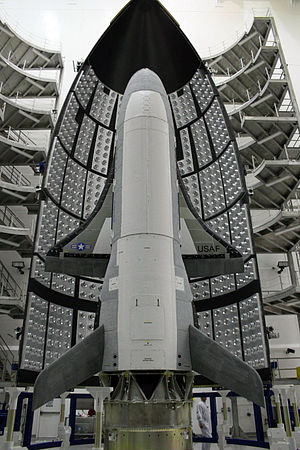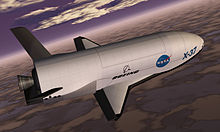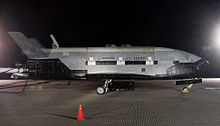Boeing X-37 Video - Overview
|
|
Boeing X-37
X-37

Picture - X-37B being prepared for launch
Role: Spaceplane
National origin: United States
Manufacturer: Boeing
First flight: 7 April 2006 (drop test);
22 April - 3 December 2010 (first spaceflight)
Status: Development and testing, one spaceflight completed
Primary users: NASA/DARPA (X-37A)
USAF (X-37B)
Number built: 2
Developed from: Boeing X-40
The Boeing X-37 Orbital Test Vehicle is an American unmanned spacecraft. It is operated by the United States Air Force for orbital spaceflight missions intended to demonstrate reusable space technologies. The X-37 is a reusable robotic spaceplane that is a 120% scaled derivative of the X-40A. It has a length of over 29 ft (8.9 m) and features two angled tail fins.
The X-37 began as a NASA project in 1999, then was transferred to the U.S. Department of Defense in 2004. It had its first flight as a drop test on 7 April 2006, at Edwards Air Force Base. The spaceplane's first orbital mission, USA-212 was launched on 22 April 2010 using an Atlas V rocket. Its return to Earth on 3 December 2010 was the first test of the vehicle's heat shield and hypersonic aerodynamic handling.
Development
In 1999 NASA selected Boeing Integrated Defense Systems to design and develop the vehicle, built by the California branch of Boeing's Phantom Works. Over a four-year period NASA contributed $109 million, the US Air Force $16 million, and Boeing $67 million to the project. In late 2002 a new $301 million contract was awarded to Boeing in the framework of NASA's Space Launch Initiative.
The X-37 was transferred from NASA to the Defense Advanced Research Projects Agency (DARPA) on 13 September 2004. The program has become a classified project, although it is not known whether DARPA will maintain this status for the project. NASA's spaceflight program may be centered around the Crew Exploration Vehicle, while DARPA will promote the X-37 as part of the independent space policy that the US Department of Defense has pursued since the Challenger disaster.
The X-37 was originally designed to be carried into orbit in the Space Shuttle cargo bay, but underwent redesign for launch on a Delta IV or comparable rocket after it was determined that a shuttle flight would be uneconomical. The X-37's aerodynamic design was derived from the Space Shuttle, hence the X-37 has a similar lift-to-drag ratio, and a lower cross range at high altitudes and Mach numbers than DARPA's Hypersonic Technology Vehicle.
As part of its Space Support mission goals, X-37 was designed to rendezvous with friendly satellites to refuel them, or to replace failed solar arrays using a robotic arm. Its payload could also support Space Control (Defensive Counter-Space, Offensive Counter-Space), Force Enhancement and Force Application. An early requirement for the spacecraft called for a delta-v of 7,000 mph (3.1 km/s) to change its orbit.
Glide tests
The vehicle that was used as an atmospheric drop test glider had no propulsion system. Instead of an operational vehicle's payload bay doors it had an enclosed and reinforced upper fuselage structure to allow it to be mated with a mothership. In September 2004 DARPA announced that for its initial atmospheric drop tests the X-37 would be launched from the Scaled Composites White Knight, a high-altitude research aircraft.
On 21 June 2005 the X-37 completed a captive-carry flight underneath the White Knight from Mojave Spaceport, Mojave, California. Through the second half of 2005, the X-37 underwent structural upgrades including reinforcement of the nose wheel supports. Further captive-carry flight tests and the first drop test were expected mid-February 2006. The X-37's public debut was scheduled for its first free flight on 10 March 2006, but was canceled due to an Arctic storm. The next attempt at flight on 15 March 2006 was canceled due to high winds.
On 24 March 2006, the X-37 flew, but a data link failure prevented the free flight and the vehicle returned to the ground still attached to its White Knight carrier. On 7 April 2006, the X-37 made its first free glide flight. During landing, the vehicle overran the runway and it sustained minor damage.
Following an extended downtime while the vehicle was repaired, the program moved from Mojave to Air Force Plant 42 (KPMD) in Palmdale, California for the remainder of the flight test program. White Knight continued to be based at Mojave, but would ferry over to Plant 42 when flights were scheduled. Five additional flights were performed, two of which resulted in X-37 releases with successful landings. These free flights occurred on 18 August 2006 and 26 September 2006.
X-37B Orbital Test Vehicle

Picture - X-37 spacecraft, artist's rendering from 1999
On 17 November 2006 the U.S. Air Force announced it would develop the X-37B from the NASA X-37A. The Air Force version is designated X-37B Orbital Test Vehicle (OTV). The OTV program builds on industry and government investments by DARPA, NASA and the Air Force. The X-37B effort will be led by the Air Force Rapid Capabilities Office, and includes partnerships with NASA and the Air Force Research Laboratory. Boeing is the prime contractor for the OTV program. The X-37B can remain in orbit for up to 270 days at a time.
The Secretary of the Air Force states the OTV program will focus on "risk reduction, experimentation, and operational concept development for reusable space vehicle technologies, in support of long-term developmental space objectives."
The X-37B was originally scheduled for launch in the payload bay of the Space Shuttle, but following the Columbia accident, it was transferred to a Delta II 7920. It was subsequently transferred to a shrouded configuration on the Atlas V following concerns over the unshrouded spacecraft's aerodynamic properties during launch. Following their missions, X-37B spacecraft are to land on a runway at Vandenberg Air Force Base, California, with Edwards Air Force Base as an alternate site.
Manufacturing on a second X-37B began in 2010. The second spacecraft is being completed and readied for a launch in spring 2011.
Design
The X-37 is expected to operate in a velocity range of up to Mach 25 on reentry. Among the technologies to be demonstrated with the X-37 are improved thermal protection systems, avionics, the autonomous guidance system and an advanced airframe. The vehicle is powered by a Rocketdyne AR2-3 engine. The AR2-3 was the human-rated rocket powerplant for the dual-power NF-104A astronaut training vehicle and was given a new flight certification for use on the X-37 with hydrogen peroxide/JP-8 propellants. The X-37B now uses a hydrazine monopropellant rocket.
The X-37 has a payload bay available for experiments and other space payloads. It features thermal protection systems that are improved from previous generations of spacecraft. The thermal protection system uses improved silica ceramic tiles.
Operational history

Picture - The X-37B sits on the runway at Vandenberg AFB after landing
The first orbital flight of the first X-37B, named USA-212, was launched on an Atlas V rocket at Cape Canaveral Air Force Station, Florida on 22 April 2010, at 23:58 GMT. The spacecraft was placed into low Earth orbit for testing.
While the U.S. Air Force revealed few orbital details after the first X-37B was successfully placed in orbit due to the secretive nature of the mission, amateur astronomers claimed to have identified the experimental spacecraft in orbit and shared their findings. A worldwide network of amateur astronomers reported that as of 22 May it was in an inclination of 39.99 degrees, circling the Earth once every 90 minutes in an orbit 401 by 422 kilometers (249 by 262 mi).

Picture - Personnel inspect the first X-37B after its return
The China Daily newspaper wrote that the X-37B program raised concerns about an arms race in space. The Xinhua News Agency took a more moderate tone in questioning if the secretive program might lead to weapons in space. The Pentagon has strongly denied claims that the X-37B's mission supports the development of space-based weapons. A group of amateur sky watchers with members around the globe has concluded that the spacecraft's mission is to support space-based surveillance and reconnaissance technology; they reported the X-37B's track took it over North Korea, Afghanistan and other trouble spots. According to them, the spacecraft passes over the same given spot on Earth every four days, and operates at an altitude of 255 miles (410 km), which would be typical for a military surveillance satellite.
The U.S. Air Force announced on 30 November 2010 that the X-37 would return for a landing during the 3-6 December timeframe. As scheduled, the X-37B de-orbited, reentered Earth's atmosphere, and landed at Vandenberg AFB on 3 December 2010, at 1:16 PST (09:16 UTC). The X-37B had a tire blowout during landing and sustained minor damage to its underside. A second X-37B is scheduled for launch from Cape Canaveral on 4 March 2011.
Specifications
X-37B
Data from USAF, Boeing, Air & Space Magazine Physorg.com,
General characteristics
Crew: None
Length: 29 ft 3 in (8.9 m)
Wingspan: 14 ft 11 in (4.5 m)
Height: 9 ft 6 in (2.9 m)
Loaded weight: 11,000 lb (4,990 kg)
Power: Gallium arsenide solar cells with lithium-ion batteries
Payload Bay: 7 x— 4 ft (2.1 x— 1.2 m)
Performance
Orbital speed: 17,500 mph (28,200 km/h)
Orbit: Low Earth orbit
Orbital time: Up to 270 days
DARPA Falcon Project
Boeing X-20 Dyna-Soar - the US Air Force's previous spaceplane, was canceled in the 1960s.
Related development
Boeing X-40
Comparable aircraft
Avatar (rocket)
Orbital Sciences X-34
Bibliography
Bentley, Matthew A. Spaceplanes: From Airport to Spaceport. New York: Springer, 2008. ISBN 978-0-387-76509-9.
Gump, David P. Space Enterprise: Beyond NASA. Westport, CT: Praeger Publishers, 1989. ISBN 978-0-275-93314-2.
Miller, Jay. The X-Planes: X-1 to X-45. Hinckley, UK: Midland, 2001. ISBN 1-85780-109-1.
Yenne, Bill. The Story of the Boeing Company. Minneapolis, MN: Zenith Press, 2005. ISBN 978-0-7603-2333-5.
Boeing X-37 Pictures
Living Warbirds: The best warbirds DVD series.
Source: WikiPedia